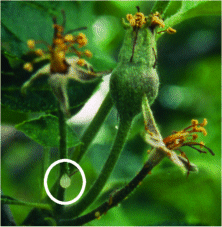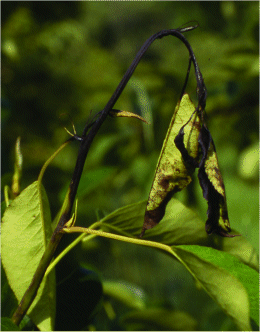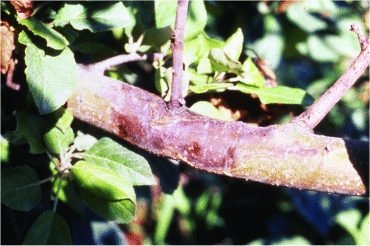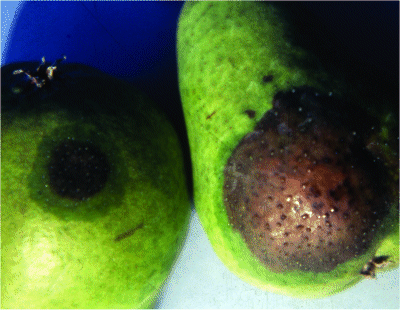What is fire blight?
Fire blight, caused by Erwinia amylovora, is a bacterial disease of apple, pear, hawthorn, crabapple and ornamentals in the Rosaceae family. The disease can result in the loss of branches and tree structure. In severe cases, when the bacteria progresses into the trunk or infects the rootstock, entire trees can be killed. The severity of disease is dependant on cultivar and rootstock susceptibility, general tree health, cultural practices and environmental conditions. Economic losses to fire blight occur due to a loss of fruit-bearing surface and tree mortality. Trees may need to be removed and replanted or, in severe cases, whole blocks of trees may need to be replaced.
What does fire blight look like?
The symptoms of fire blight depend on the part of the part of the tree that is attacked. Blossom blight (Figures 1 and 2) results in blackened/shrivelled blossom clusters. Shoot blight (Figures 3 and 4) is characterized by the typical 'shepherd's crook' symptom. Cankers (Figures 5, 6 and 7) form once fire blight progresses into larger branches, trunk and the rootstock. Cankers are typically smooth edged when first formed, but the margins become cracked and more pronounced with time. Infections can also be identified by the discharge of bacterial ooze from infected plant surfaces.
Where does fire blight come from?
Fire blight bacteria overwinter in cankers or strikes on host trees. In the spring, the bacteria can multiply very quickly, causing the surfaces of cankers to ooze bacteria. Bacteria are spread to blossoms by insects (for example flies, honeybees) and splashing rain. Rainfall, high relative humidity and/or dew allow the bacteria to travel into the stigma of flowers and into the tree. Blossom infections often result in shoot infections later in the season.
How do I save my trees once they are infected with fire blight?
There is no cure for fire blight, but the spread of bacteria can be limited by using sound pest management strategies in an integrated management program. Such a program should include diligent pruning to remove cankers in the winter, pruning during the growing season the removal of blight symptoms as they appear, a balanced nutrition program and the use of prediction models to determine appropriate timing for the application of control products to limit the spread of the disease.
How do I avoid problems with fire blight in the future?
Today, the trend is to plant higher density orchards with more valuable cultivars (many of which are highly susceptible to fire blight), making it difficult to avoid the disease all together. Risks can be minimized by selecting cultivars and rootstocks carefully when planting new orchards (a list of the susceptibility of some common cultivars and rootstocks is included in this publication). Sites chosen for orchards should have well drained soils with a pH between 5.5 and 6.5 and have adequate organic matter. The application of excess nitrogen should be avoided. An integrated pest management program for sucking-piercing insects (for example leafhoppers, aphids, plant bugs) should be implemented. An annual pruning program to remove as many fire blight cankers as possible is critical. The use of control products (copper or Bordeaux mixture before buds open, streptomycin for blossom blight control in combination with a prediction model to time bloom applications) will help limit disease spread. The use of Apogee® in mature bearing trees where blossom blight has been detected may help reduce susceptibility to the disease. With all the different factors involved in fire blight management, integrated pest management strategies are essential.
Methods for Fire Blight Management in Your Orchard
This factsheet contains information on a variety of practices that you can use to help manage fire blight. To obtain optimal control of the disease, an integrated pest management approach must be used, taking each of the factors described into consideration.
Blossom Blight
Figure 1: Blossom blight symptoms on pear. Photo credit: British Columbia Ministry of Agriculture and Land.

Figure 2: Early shoot blight symptoms, note: 'Bacterial ooze'. Photo credit: EarthTramper Consulting Inc.

Shoot Blight
Figure 3: Shoot blight symptoms - 'Sheaperd's crook'. Photo credit: EarthTramper Consulting Inc.

Figure 4: Shoot blight symptom on pear. Photo credit: EarthTramper Consulting Inc.

Canker
Figure 5: Rootstock canker. Photo credit: EarthTramper Consulting Inc.

Figure 6: Canker (smooth) on branch. Photo credit: EarthTramper Consulting Inc.

Figure 7: Canker (cracked) on branch. Photo credit: EarthTramper Consulting Inc.

Fruit Infections
Figure 8: Advanced blight symptoms on pear fruit. Photo credit: EarthTramper Consulting Inc.

Figure 9: Advanced blight symptoms on apple fruitlet. Photo credit: EarthTramper Consulting Inc.

Site Selection
- Avoid low-lying land with frost pockets and sites with heavy clay soils.
- Proper drainage is essential. Tile drains may need to be installed.
- Wild hosts in hedge rows and nearby neglected apple and pear orchards should be removed.
- Soil tests should be done prior to planting (nutrients, pH, organic matter, nematodes) and corrective actions taken.
Cultivar and Rootstock Selection
- Cultivars and rootstocks with resistance to fire blight should be chosen when feasible.
- If this is impractical, due to market demand, other steps can be taken to reduce infection risk:
- For young non-bearing trees, blossoms should be removed before opening (during dry weather and when no rain is expected over the next 24-48 hours).
- For bearing trees, secondary blossoms should be removed every few days after primary bloom is complete where feasible (that is, high density orchards).
- Susceptible rootstocks (such as M.9, M.26 and Ott.3) should be avoided, especially in geographic locations where annual incidence of fire blight is high.
- Where available, resistant rootstocks (such as B.9 or the CG series) should be used.
Vigour Management
- Conduct annual soil and leaf sampling to ensure a balanced nutrient program.
- Do not over-fertilize trees. Excess nitrogen will cause vigorous shoot growth, making trees more susceptible to fire blight and over longer periods of time.
- To reduce the risk of late season infections, fertilizer applications should be properly timed to avoid a late flush of growth.
- Avoid excessive pruning, as it may trigger excessive shoot growth.
Manual Manipulation of Fruit Load and Vegetative Growth
- In orchards where fire blight is present, hand thinning, bud pinching and other manipulation activities should be avoided until after terminal bud set. (Although delaying hand thinning may result in some loss of fruit size, the risk of spreading blight usually out-weighs the benefits of larger fruit).
Chemical Thinning at Bloom
- Blossom thinning spray that burn stigma tips are beneficial. They are likely to prevent the continued build-up of bacteria and may reduce the overall inoculum level on blossoms in the block for a few days after application.
Reduction of Humidity in the Orchard Microclimate
- To increase air circulation and reduce humidity, orchard sod should be kept mowed, weed growth kept to a minimum and trees well pruned.
- Overhead irrigation should not be used when blossoms are present and temperatures are favourable to fire blight infection.
Insect Integrated Pest Management
- Orchard blocks should be monitored on a regular basis for presence of sucking insects (for example aphids, plant bugs and leafhoppers), as they can spread the disease.
- Appropriate integrated pest management practices should be used to reduce insect pest populations
Dormant Pruning: Orchard Sanitation
Pruning out fire blight cankers during the dormant season will reduce the number and distribution of sources of primary inoculum, which can fuel the next blight epidemic. This is best accomplished by removing and burning all infected (cankered) limbs each winter. This process should be conducted before any normal dormant pruning occurs.
- Identification of fire blight cankers:
- Overwintering cankers may have smooth or cracked (Figures 6 and 7) margins.
- Infected terminal shoots display “shepherd’s crooking”(Figures 3 and 4) and tend to have leaves still attached.
- Cankers are most visible on bright sunny days.
- When to do it:
- After harvesting operations are complete, walk several times through the orchard and identify cankered trees, marking them with bright-coloured paint or tape in order to be able find them again during the winter.
- Conduct pruning in late winter, before sap flow begins.
- What to do:
- Prune below the visible margins of the canker.
- Sterilization of pruning tools between cuts is not necessary in the winter.
- For larger limbs, if the canker does not surround more than half of a large branch or trunk, it can sometimes be removed by scraping. To do this, remove all infected bark and discoloured underlying tissue, plus an additional 2.5 cm (1 inch) of infected tissue around the margin of the canker. Cutting and scraping should be done perpendicular to the branch to encourage rapid healing. The wound can be swabbed with 70% denatured alcohol or a 10% bleach solution, or sprayed with Lysol®. Tree paint or a commercial wound dressing can then be applied if desired.
- Remove all prunings from the orchard and burn them.
Pruning during the Growing Season
Pruning out infections during the growing season can be extremely effective at limiting the number and distribution of secondary canker and shoot infections as well as reducing the risks for serious damage following summer hail and wind storms. Recommendations for removing fire blighted wood from the orchard during the growing season vary. Some experts advise pruning infected wood as soon as symptoms are visible, while others advise leaving the blighted terminals to “wall off” themselves and then dormant prune.
- Consider pruning during the growing season when:
- Symptoms are present in blocks with highly susceptible cultivars.
- Symptoms are present in non-bearing and young high density plantings.
- Trees are growing vigorously and soil fertility is high.
- There is a risk of fire blight spreading to nearby blocks.
- When a neighbour has identified fire blight in his/her orchard.
- Scouting for fire blight
- Starting at bloom, scout for fire blight cankers (Figures 6 and 7) missed during winter pruning operations and blossom infections every 3 to 4 days.
- After petal fall, continue to scout for shoot blight symptoms (Figures 3 and 4) until terminal bud set.
- Concentrate on blocks with susceptible cultivars and a history of fire blight.
- What to do
- Remove infections (blossom and shoot blight) as soon as they are found.
- It is essential to prune infected branches at least 30-40 cm below the visibly diseased part.
- When practical, dip tools in a disinfectant between each cut (denatured alcohol or 1:10 dilution of bleach to water).
- Flag all trees that are pruned and pay special attention to them during future scouting.
- Remove all blighted prunings from the orchard and burn them immediately.
- Salvage as much of the tree structure and bearing surface as possible.
- For infections that have progressed to 2nd or 3rd year wood, the 'ugly stub' method should be used. For this method, cuts are made into wood that is at least 2 years old, taking advantage of natural physiological resistance.
Leave a 5 to 10 cm (2 to 3") stub. Follow-up with dormant pruning to remove the stub completely. - If collar rot develops on susceptible rootstock and if fire blight is a significant problem, it is advisable to remove the entire tree from the orchard immediately and to burn it.
- When to do it:
- Monitoring should begin at the tight cluster to pink stage.
- Fire blight tends to stop spreading within the tree and between trees when terminal buds set in mid-summer. At this point, no further pruning should be required.
- Precautions:
- Excessive pruning may encourage a late flush of terminal growth, which will remain susceptible to infection later in the season.
- During serious outbreaks, regular summer pruning (other than the removal of strikes) should be avoided as there is a risk of spreading the infection.
- Avoid pruning during wet weather or when severe weather (hail, heavy rain, storms) is expected in the next 24 hours.
Prediction Models
- Prediction models can be used to tell you when infection potentials are high and when you need to make an application of a control product. Cougarblight, a prediction model for use during bloom, is the simplest and most available method to use. The model can be accessed for free on the Washington State University website.
- Prediction models, like Cougarblight and MaryBlyt©, are extremely valuable management tools and their use is encouraged for apple or pear grower that have experienced fire blight in their orchard.
Registered products and their use
Be sure to carefully read the label of any product that you intend to us in your orchard.
- Copper (registered for use in Canada)
- Provides an inhibitory barrier over the bark of the tree and helps prevent bacteria from colonizing these areas.
- Coverage must be thorough and it must be applied to all trees, including non-susceptible cultivars which can harbour the bacteria.
- Copper sprays can cause fruit russeting. They should never be used alone after green tip (that is, should be used as a Bordeaux mixture).
- Streptomycin (registered for use in Canada)
- This antibiotic inhibits the growth of the bacterial pathogen on the surface of the plant.
- Good coverage is essential
- Any blossom open at the time of application is protected until its petals begin to fall and natural resistance comes into play.
- Blossom blight control is most effective when temperatures are warm (over 18°C) and dry.
- Application timing should always be based on a prediction model.
- The product breaks down quickly in sunlight and must be reapplied every 2-3 days if conditions continue to favour infection.
- Apogee® (registered for use in Canada)
- Registered in 2005, this product is a growth regulator and will help limit shoot blight symptoms by reducing terminal shoot growth and inducing earlier “hardening off” of terminals. Once terminal bud set occurs, the shoots also become less attractive to sucking insects.
- Very effective on mature, bearing trees at appropriate rates.
- Needs to be applied 2 weeks prior to the occurrence of favourable weather for shoot blight infections.
- Bacterial antagonists
- Currently, there are no bacterial antagonists registered in Canada for the control of fire blight in apple or pear, but two products, BlightBan (Nufarm Agricultural Inc.) and Bloomtime (North West Agricultural Products), were submitted for Canadian registration in 2005.
- These products are biological control agents that establish themselves and rapidly multiply on apple and pear blossoms.
- They work by competing with the fire blight bacteria for space on the surface of flowers, thereby preventing the fire blight bacteria from colonizing the sites occupied by the bacterial antagonist.
- If registration is approved, applications will be recommended at early (15-20%) bloom and again 5-7 days later, followed by the use of Streptomycin sprays timed with the use of a predictive model.
Selected References
- British Columbia Ministry of Agriculture and Lands; 2000. Fire blight of apple and pear.
- Solymár, B.D., G. Walker, N. Carter and G. Bonn; 2002. Fire blight of apple and pear in Ontario. Ontario Ministry of Agriculture, Food and Rural Affairs, Agdex. 634/210.
- Steiner, P.W; 2000. Biology and Epidemiology of Fire Blight. West Virginia University.
- van der Zwet, T. and H.L. Keil; 1992 (revised in 1995 and 1999). Fire Blight - It's Nature, Prevention and Control: A Practical Guide to Integrated Diseaes Management. Agricultural Information Bulletin No. 631, US Dept. of Agriculture, Washington, D.C.: 91 pp.
- Vanneste, J.L. (Ed.); 2000. Fire Blight: The Disease and Its Causitive Agent, Erwinia amylovora. CABI Publishing, London, UK: 370 pp.
Fire Blight Susceptibility of North American Apple & Pear Cultivars and Rootstocks
| Least Susceptible |
Moderately Susceptible |
Highly Susceptible |
|
|---|---|---|---|
| Apple | Enterprise [1] Freedom [1] Jonafree [2],[3] Liberty [1],[2] Macfree [2] Northern Spy [2],[3] Red Delicious [1],[2] Redfree [2],[3] |
Ambrosia [5] Cameo [4] Cortland [2] Creston [4] Empire [1] Golden Delicious [1],[2],[3] GoldRush [1] Golden Supreme [5] Granny Smith [2] Gravenstein [2] Honeycrisp [5] Jerseymac [2] Macoun [2] McIntosh [1],[2],[3] Nova Easygro [1] Nova Mac [5] Pioneer Mac [4] Sansa [4] Spartan [1],[2] Summerred [1] Sunrise [4] Yataka [4] |
Braeburn [1],[3] Fuji [1],[3] Gala [1],[3] and Gala-types Ginger Gold [1],[3] Golden Russet [5] Idared [1],[2] Jonagold [1],[2] Jonathan [2] Lodi [2] Mutsu [1],[2] Paula Red [2],[3] Pink Lady [5] Rome Beauty [1] Spigold [2] Tydeman [2] Wealthy [2] Yellow Transparent [5] |
| Crabapple | Dolgo [1] | Manchurian [1] Snowdrift [1] |
|
| Malus Rootstock | B.9 [5] M.7 [1] Robusta [5] Considered resistant: Cornell-Geneva (CG®) series [5] |
MM.106 [1] MM.111 [1] M.4 [1] |
M.9 [1] M.26 [1] M.27 [1] Mark [1] Ottawa 3 [1] |
| Pear | Considered resistant: Harrow Crisp [1] Harrow Delight [1] Harrow Gold [1] Harrow Sweet [1] Harvest Queen [1] |
Kiefer [5] Magness [5] Moonglow[5] Seckel [1] Spartlett [5] |
Anjou [1] Bartlett [1] Bosc [1] Cascade [1] Clapp’s Favorite [5] Comice [5] Flemish Beauty [1] Starkrimson [1] |
| Asian Pear | Kosui [1] Chojoro [1] Seuri [1] Shinko [1] Shinsui [1] Singo [1] |
Hosui [1] Shinseiki [1] 20th Century [1] |
|
| Pyrus Rootstock | Old Home (OH) [1] OH x Farmingdale [1] |
OHF 51 [1] | Bartlett [1] Quince [1] |
| [1] from OMAF and BC websites [2] from MSU website, Nancy J. Butler, 'Diseases on Apples' [3] from WV University, Kearneysville website, Keith Yoder and Alan Biggs [4] from Drs. Steven Miller and Alan Biggs in NE183 plot, WV [5] from other field observations and Cornell University data |
|||
This document was researched and assembled by Bernt Solymár of EarthTramper Consulting inc. and Tim MacDonald of Agriculture and Agri-Food Canada for the Canadian Horticultural Council. It has been reviewed and approved by experts in the field of integrated pest management. Funding for this publication was provided by the Pest Management Centre, Agriculture and Agri-Food Canada. Information on pesticides and pest control techniques are provided for information purposes only. Information contained in this publication is not intended to be used by growers as a production guide. Provincial publications should be consulted by growers for this information. Every effort has been made to ensure that the information in this publication is complete and accurate. Agriculture and Agri-Food Canada does not assume liability for errors, omissions, or representations, expressed or implied, contained in any written or oral communication associated with this publication. Errors brought to the attention of the authors will be corrected in subsequent updates.